
26 Days Sichuan-Tibet Cycling Tour from Chengdu to Lhasa

Tour Overview
26 Days Cycling from Chengdu to Lhasa by the national highway G318, the total distance is about 2154km. And there are two mountains over 5000 meters and ten mountains...
Code of Tour: YCT0000004336
Length of Travel: 23 Day
Destinations of Tour: Chengdu - Kangding - Litang - Mangkang - Bayi - Lhasa
Departure City: Chengdu
Price of Tour: Request
Type of Tour:
Features of Tour: Cycling
26 Days Cycling from Chengdu to Lhasa by the national highway G318, the total distance is about 2154km. And there are two mountains over 5000 meters and ten mountains with altitude of over 4000 meters to cross over by highway. The bike ride on this route will take over 20 days to finish, and need to climb one mountain by highway in every 2 days. Difficult as it is, the road abounds with extraordinary natural scenery from plain to plateau, from forest to snow-capped mountain, and deep gorge, etc. The raging torrent from Qinghai-Tibet plateau will accompany you all the way.
Highlights
- Ultimate mountain bike holiday from Sichuan to Tibet
- Hugely rewarding Tibetan cycling journey
- Fabulous views along the journey
- A worthy challenge for one’s physical and mental strength
Brief Itinerary
- Day 1: Chengdu-Yaan
- Day 2:Yaan-Xingou
- Day 3: Xingou – Luding
- Day 4: Luding – Kangding
- Day 5: Kangding – Xinduqiao
- Day 6: Xinduqiao – Yajiang
- Day 7: Yajiang – Xiangkezong
- Day 8: Xiangkezong – 158 Daoban
- Day 9: 158 Daoban – Litang
- Day 10: Litang – Batang
- Day 11: Batang – Mangkang
- Day 12: Mangkang – Dengba
- Day 13:Dengba – Zuogong
- Day 14: Zuogong – Bangda
- Day 15: Bangda – Basu
- Day 16: Basu – Ranwu
- Day 17: Ranwu-Bomi
- Day 18: Bomi – Tongmai
- Day 19: Tongmai – Lulang
- Day 20: Lulang – Bayi
- Day 21: Bayi – Gongbo’gyamda
- Day 22: Gongbo’gyamda – Songduo
- Day 23: Songduo – Lhasa
- Day 24: Lhasa
- Day 25: Lhasa
- Day 26: Lhasa Departure
Google Map
Detailed Itinerary
Day 1 Start from Chengdu to Yaan (155km cement road)
Sightseeing and Activities:sightseeing on the way
Accommodation:
Meals:
Our first destination is Ya’an, 120 kilometers (75 miles) southwest of Chengdu. This route needs to pass through Qionglai City and Mingshan County. The road between Chengdu and Mingshan is relatively flat but rises to a slope.
Detailed route:
Chengdu City (alt.512m) – Shuangliu County – Xinjin County – Qionglai City – Mingshan County – Yaan City (alt.641m)
Stay overnight in Yaan.
Day 2 Yaan – Xingou (87km cement road along with Qingyi River)
Sightseeing and Activities:Qingyi River, Erlangshan Mountain, Xigou village
Accommodation:
Meals:
Today’s journey is cycling along the beautiful Qingyi River. First ride to Tianquan County, a picturesque location nestled at the east foot of Erlangshan Mountain. Erlangshan Mountain boasts of its charming natural scenery and many minority villages. Then continue to Xigou village.
Detailed route:
Yaan City (alt.641m) – Feixianguan Town – Tianquan County (alt.848m) – Zishi Village – Lianglu Village or called Xingou (alt.1330m)
Stay overnight in Xingou.
Day 3 Xingou – Luding (57km cement road)
Sightseeing and Activities:Riyu Gaoyuan Sightseeing Terrace, Dadu He Sightseeing Terrace, Luding Bridge and the museum
Accommodation:
Meals:
Today we will reach the Qinghai-Tibet Plateau after passing through Erlangshan Tunnel, and stop at Riyu Gaoyuan Sightseeing Terrace and Dadu He Sightseeing Terrace respectively for a while. Upon arrival in Luding County, visit Luding Bridge and the museum.
Detailed route:
Xingou (alt.1330m) – Erlangshan Tunnel (alt.2170m) – Luding County (alt.1330m)
Stay overnight in Luding.
Day 4 Luding – Kangding (51km part gravel road and part cement road)
Sightseeing and Activities:Dadu River, Kangding
Accommodation:
Meals:
Bike along the road following the true right of the Dadu River for around 24 km north before turning west for 27 km to Kangding. But crossing the famous suspension bridge,tourists will see the scene of a perhaps apocryphal story about the Revolutionaries swinging across hand over hand after the Kuomintang had torn up the planks. You might be amazed that the route led up a hellish switchback as you see zig-zagging up and over the mountain opposite.
Detailed route:
Luding County (alt.1330m) – Wasigou – Xiaotiandu Tunnel – Kangding County (alt.2395m)
Stay overnight in Kangding.
Day 5 Kangding – Xinduqiao (82km cement road)
Sightseeing and Activities:Zheduo Mountain, Gongga Mount
Accommodation:
Meals:
Today, we will challenge the 4300 meter high Zheduo Mountain firstly. It is about 36 km to mountain pass, but all upward road, you may need to push your bike most of the time. Once you arrive at the mountain pass, your attention will immediately be drawn to the new view of wide Tibetan plateau.
Endless waving hilltops, yaks, river, welcome to Tibetan plateau! There are great views of Gongga Mount and other mountains.
And just ride 42 km down to the colorful small town of Xinduqiao with several nicer looking places to stay. Just enjoy the beautiful villages and land all the way.
Detailed route:
Kangding County (alt.2395m) – Zheduotang Village (alt.3222m) – Zheduo Pass (alt.4298m) – Xinduqiao Town (alt.3630m)
Stay overnight in Xinduqiao.
Day 6 Xinduqiao – Yajiang (71km part gravel road and part cement road)
Sightseeing and Activities:Sightseeing on the way
Accommodation:
Meals:
Today is a challenging day again, but with enjoyable views. 5km west of Xinduqiao is a junction with a road heading north (surfaced) to Danba and Daofu. The road west climbs to 4412m and then crosses a bleak, windswept grassy plateau for about 5.5km with a maximum altitude of 4475m. It then descends steeply.
The road then descends into Yajiang, just below 3000m, there are a few truck stops from 12km beforehand which are much cheaper than the only foreigner licenced hotels in the town. The road to Yajiang was all tarmac but sometimes quite bumpy, traffic was light. Yajiang has shops selling all essentials, a covered market and internet access.
Detailed route:
Xinduqiao Town (alt.3630m) – Gao´ersi Pass (alt.4412m) – Yajiang County (alt.2530m)
Stay overnight in Yajiang.
Day 7 Yajiang – Xiangkezong (17km cement road)
Sightseeing and Activities:Xiangkezong Village
Accommodation:
Meals:
From Yajiang the road climbs to 3500m to Xiangkezong Village that is a traditional village which is worth staying overnight at. We will have a good rest in the village and prepare for tomorrow’s arduous cycling.
Detailed route:
Yajiang County (alt.2530m) – Xiangkezong Village (alt.3500m)
Stay overnight in the village.
Day 8 Xiangkezong – 158 Daoban (59km cement road under construction)
Sightseeing and Activities:Sightseeing on the way
Accommodation:
Meals:
We will cycle in the sky in the whole day. From the Xiangkezong Village, the road keeps climbing to 4659km at Jianziwan Pass, then to 4718m at Kazila Pass which is today’s highest pass. Then ride down to 158 Daoban.
Detailed route:
Xiangkezong Village (alt.3500m) – Jianziwan Pass (alt.4659m) – Kazila Pass (alt.4718m) – Leida Military Depot (alt.4387m) – 158 Daoban (alt.4090m)
Stay overnight at 158 Daoban.
Day 9 158 Daoban – Litang (46km cement road)
Sightseeing and Activities:Sightseein on the way
Accommodation:
Meals:
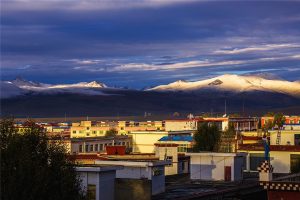
From 158 Daoban to Litang, the road climbs and falls repeatedly. We will overcome several passes over 4000m to get to today’s final destination – Litang. Litang gained reputation of the highest city in all over the world for its sea level of 4200meter and is famous for its international horse racing festival of every August 1st. The area is flat with a wide valley surrounding it.
Detailed route:
158 Daoban (alt.4090m) – Unknown Pass (alt.4321m) – Honglong Village (alt.4321m) – Unknown Pass (alt.4377m) – 118 Daoban (alt.4008m) – Unknown Pass (alt.4312m) – Litang County (alt.4014m)
Stay overnight in Litang.
Day 10 Litang – Batang (187km cement road)
Sightseeing and Activities:Haizi Mountains
Accommodation:
Meals:
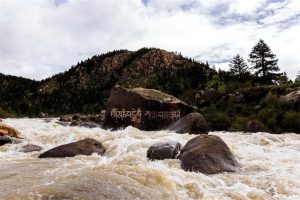
Depart from Litang we will get into the Haizi Mountains. It was called as Haizi Mountain and the road condition from east to the west is good. And you will be surprised how fast and easy the summit can be reached before you know.
And then we will go down to the Batang which is located in the bank of Jinshajiang River. Batang is the well-known supplier of good fruit in eastern Tibet. It was said that the apple had been planted by a foreign preacher firstly. And the Christian churches here are still well protected now.
Today we will go through many tunnels, all of which are without lights. Batang is our last stop before Tibet.
Detailed route:
Litang County (alt.4014m) – Haizi Pass (alt.4685m) – Haizishan Police Station – Deda Tunnel (length 659m) – Lieyi Tunnel (length 2107m) – 323 Daoban (alt.3370) – Bogexi Tunnel (length 2743m) – Lanashan Tunnel (length 3451m) – Huangcaoping No.1 Tunnel (length 1221m) – Huangcaoping No.2 Tunnel (length 917m) – Batang County (alt.2580m)
Stay overnight in Batang.
Day 11 Batang – Mangkang (108km part gravel road and part cement road)
Sightseeing and Activities:Sightseeing on the way
Accommodation:
Meals:
Leaving Batang, a flat road will lead you to Zhubalong Village easily located at the east bank of the Jinshajiang River. Across the Bridge of Jinshajiang and over the Zhongbala Mountain, you will reach the Mangkam County, Tibet.
Mangkang is at the junction of roads to Sichuan, Yunnan and Tibet provinces. It is the first county you can have a lodge in the hostel and appreciate a warm meal after you enter in Tibet. It is located 1 kilometer away from the National Highway 318, and you can stay overnight in the local Weather Bureau rest house to take a bath and prepare for the Tibet part bicycle tour.
Detailed route:
Batang County (alt.2580m) – Jinsha River Bridge (alt.2451m) – Hotspring Cottage (alt.2635m) – Haitong Military Depot (alt.3536m) – Zongbala Pass (alt.4170m) – Mangkang County (alt.3875m)
Stay overnight in Mangkang.
Day 12 Mangkang – Dengba (91km gravel road)
Sightseeing and Activities:Lawu Mountain Pass, Jueba Mountain, Lancang Valley
Accommodation:
Meals:
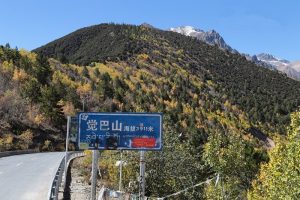
Today’s journey is cycling along the Langcang River. For the first 12 kilometers, you will get over the Lawu Mountain Pass; and the following 33 kilometers are the downhill path, the elevation will decline by 1700 meters. Then get over Jueba Mountain for about 24.5 kilometers and follow the downhill path for 13 kilometers to Dengba.
As the trail along the Lancang River is extremely steep, you need to proceed with particular caution and prudence and control your brake tightly. It is really a test for your strength and will, but the visit of the pass-by Lancang Valley will be worthwhile. The Lancang Valley is the typical mountain-valley physiognomy; the exotic site will offer a comfort to your weary body.
Detailed route:
Mangkang County (alt.3875m) – Lawu Pass (alt.4338m) – Chuka Bridge (alt.2640m) – Jueba Pass (alt.3930m) – Dengba Village (alt.3440m)
Stay overnight in Dengba (camping).
Day 13 Dengba – Zuogong (76km cement road under construction)
Sightseeing and Activities:Dongda Mountain
Accommodation:
Meals:
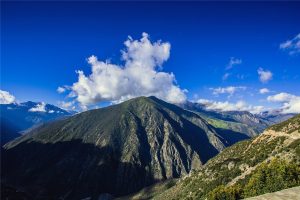
Today, continue the uphill path road for 13 kilometers to Rongxu. The elevation will raise by 1900 meters totally. Keep cycling to get over mountains and proceed for 56.5 kilometers to reach Zuogong. Most of this path is still dirty and dusty road.
Upgrade for 24.5 kilometers to cross Dongda Mountain, and downgrade for 32 kilometers to Zuogong. Dongda Mountain is the highest pass in the whole route, where the altitude has reached 5100 meters, and the uphill path will be quite strenuous. The downhill road is gentle and you can have complete relax.
Additional 10 kilometers bituminous macadam will lead you to Zuogong.
Detailed route:
Dengba Village (alt.3440m) – Rongxu Military Depot (alt.4046m) – Dongda Pass (alt.5008m) – Zuogong County (alt.3877m)
Stay overnight in Zuogong.
Day 14 Zuogong – Bangda (105km cement road)
Sightseeing and Activities:Yuqu River
Accommodation:
Meals:
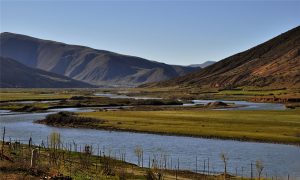
Proceed for 105 kilometers to Bangda. As the initial 63 kilometers are bituminous macadam, arrival at 3654 on the National Highway 318; for the following 42 kilometers is mainly the dusty road in poor condition with lots of uphill path. The excited thing is that there is fiber in Bangda and you can make a call there. And cycling along with Yuqu River is enjoyable, too.
Detailed route:
Zuogong County (alt.3877m) – Tiantuo Town – Tiantuo Village – Asi Village – Bangda Town (alt.4120m)
Stay overnight in Bangda military depot.
Day 15 Bangda – Basu (95km cement road and gravel road)
Sightseeing and Activities:Yela Mountain, Nujiang Bridge
Accommodation:
Meals:
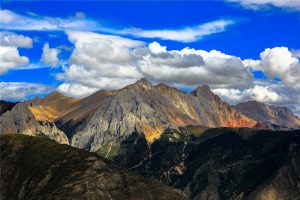
You will first cycle 75 kilometers from Bangda to Wadayue. Most of this part is still the dirty road. The former 13.5 kilometers is the up slope to get over Yela Mountain, also named as Nujiang Mountain; such a trail is relatively in good condition.
However the following 43 kilometers down slope path to Nujiang Bridge is indeed tough, with more than 50 sharp turnings of 180 degrees. This trail is often called “Nujiang 72 turnings” for its dangerous and zigzag path.
Cover another 20 kilometers to Basu. This part of road seems good in the sunny day, but it will turn extremely terrible after rain.
Detailed route:
Bangda Town (alt.4120m) – Yela Pass (alt.4658m) – Nujiang River Bridge (alt.2740m) – Basu County (alt.3280m)
Stay overnight in Basu.
Day 16 Basu – Ranwu (90km cement road))
Sightseeing and Activities:Sightseeing on the way
Accommodation:
Meals:
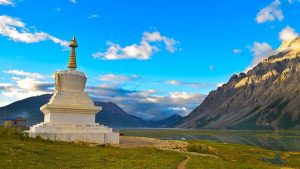
Bike 60 kilometers to Zhongsha at first. It is still the dusty and dirty road and mainly composed of uphill path.
Then cycle 30 kilometers dusty road extending to Ranwu town, a paradise place with mirror-like lake, jade-green pines and snow-capped mountains in the distance. The first 7.5 kilometers gentle upgrading roads that leads you to the Mt. Anjiula Pass, and the following 27 kilometers downgrading will lead you to fantastic Ranwu soon. You just need to ride for another 1 kilometer to reach Ranwu Lake from the Ran-Cha highway to appreciate the dream-like scenery there.
Detailed route:
Basu County (alt.3280m) – Anjiula Pass (alt.4475m) – Ranwu Town (alt.3960m) Stay overnight in Ranwu.
Day 17 Ranwu – Bomi (132km cement road)
Sightseeing and Activities:Anmucuo and Palong Tsangpu River, Midui Glacier
Accommodation:
Meals:
Today, bid fare well to Ranwu and continue to ride for Zhongba, which is 53 kilometers away. Proceed along the tempered devious path, and have a brief visit of Anmucuo and Palong Tsangpu River. As most of this path, you will go through the forestry area and linger in the mist and clouds between mountains.
Continue to the relevantly bigger town Bomi for 76 kilometers. The dirt road stretches for 36 kilometers until Songzong; and the following 40 kilometers is the bituminous macadam as gentle down slope. Plenty of Glaciers will catch your eyes on the way.
Detailed route:
Ranwu Town (alt.3960m) – Midui Glacier – Zhongba Village (alt.3330m) – Bomi County (alt.2725m)
Stay overnight in Bomi.
Day 18 Bomi – Tongmai (92km cement road)
Sightseeing and Activities:Sightseeing on the way
Accommodation:
Meals:
Today is an arduous cycling day leading you to Tongmai, covering about 90 kilometers. 40 kilometers devious path guides you to Guxiang bituminous macadam and the following 50 kilometers path will not cost you lots of strength and energy. However, it comes to atrocious when you close to Tongmai.
Detailed route:
Bomi County (alt.2725m) – Guxiang – 102 landslide area – Tongmai Town (alt.2070m)
Stay overnight in Tongmai.
Day 19 Tongmai – Lulang (33km gravel road and 41km cement road)
Sightseeing and Activities:Sightseeing on the way
Accommodation:
Meals:
Go cross Dongjiu for the first 37 kilometers and continue to Lulang Town for 37 kilometers more. When you reach Pailong, 17 kilometers from Tongmai, you will see the wreckage of Yigonghe River flood collapse, and the present path is newly- repaired. The slope is still barrier and bold and you can see the trace after flood. The trail from Tongmai to Pailong is in well condition.
Then continue for 37 kilometers after the forest ecological system Orientation and the pass-by sight just looks like tropical rain forest. Try the delicious food of Lulang Chicken Soup cooked by stone pot.
Detailed route:
Tongmai Town (alt.2070m) – Laohu Zui – Pailong country – Layue Village (alt.2372m) – Dongjiu country (alt.2560m) – Lulang Town (alt.3370m)
Stay overnight in Lulang.
Day 20 Lulang – Bayi (72.5km cement road)
Sightseeing and Activities:Sejila Mountain, Huge Cypress Park
Accommodation:
Meals:
It will be a fatigued but rewarding day for 72.5 kilometers and arrive in Bayi; you will get over Sejila Mountain for 23.5 kilometers. Sightseeing Terrace for the sea of Lulang forests is 19km away from Lulang Town. The National Highway 110 gently upgrades and you need to push your bicycle to surmount Sejila Mountain.
The latter 30 kilometers path to Nyingtri is steep and in poor condition. There are approximately 19 kilometers from Nyingtri to Bayi, and it is the even bituminous macadam. The Niyangqu and poplars dotted in emerald green constitutes picturesque scenery. The Huge Cypress Park is situated near Bayi roadside. You can find a hostel to have a rest and take a shower easily in Bayi Town.
Detaild route:
Lulang Town (alt.3370m) – Sejila Pass (alt.4559m) – Nyingchi Town (alt.3010m) – Bayi Town (alt.2930m)
Stay overnight in Bayi.
Day 21 Bayi – Gongbo’gyamda (130km cement road)
Sightseeing and Activities:Sightseeing on the way
Accommodation:
Meals:
You will enjoy the ease ride on the bituminous macadam. The blue mountains and green waters will feast you eyes all along the way and you will cover 127 kilometers arrival in Gongbo’gyamda without awareness.
Detailed route:
Bayi Town (alt.2930m) – Gengzhang Town – Baiba Town – Gongbo’gyamda County (alt.3440m)
Stay overnight in Gongbo’gyamda.
Day 22 Gongbo’gyamda – Songduo (96km cement road)
Sightseeing and Activities:Sightseeing on the way
Accommodation:
Meals:
Continue to ride on the bituminous macadam for 96 kilometers to Songduo and mainly composed of uphill path. Songduo is the only small town with room and board between Gongbu pass and Mila Pass.
Detailed route:
Gongbo’gyamda County (alt.3440m) – Jinda Town – Jiaxing country – Songduo country (alt.4288m)
Stay overnight in Songduo.
Day 23 Songduo – Lhasa (110 km cement road)
Sightseeing and Activities:Sightseeing on the way
Accommodation:
Meals:
Ride from Songduo to Mozhugongka for 110 kilometers. The first 20 kilometers is the tempered uphill bituminous macadam, but you need to push your bicycle to the second highest pass, Mila Pass (5030m), along Sichuan – Tibet Highway.
Then continue for 27 kilometers to Riduo on the bituminous macadam and head for Mozhugongka for another 56 kilometers.
Then head to your final destination – Lhasa. The last period is approximately 68 kilometers bituminous macadam. You will see the lofty Potala Palace, as you enter in the Lhasa Forestry checkpoint in the distance. The challenging tour ends here and you might feel as comfortable as home at that moment.
Detailed route:
Songduo country (alt.4288m) – Mila Pass (alt.5013m) – Riduo country (alt.4370m) –Mozhugongka County (alt.3830m) – Datse County (alt.3440m) – Lhasa City (alt.3650m)
Stay overnight in Lhasa.
Day 24 Lhasa
Sightseeing and Activities:Potala Palace, Johkang Temple, and Barkhor Street
Accommodation:
Meals:
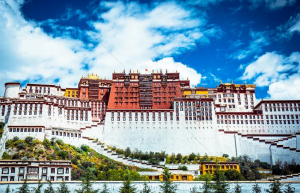
Today’s tour will first bring you to the Potala Palace which is the winter palace of the Dalai lama. It was put to use since the 7th Century by the 33rd great king of Tibet. The most valuable collections of Potala Palace are the gilded burial stupas of former Dalai Lamas and meditation Cave of the 33rd great king of Tibet.
Then after lunch, tourists head to Jokhang temple which was founded by the 33rd great king of Tibet in the 7th century. Inside you can see the statue of Buddha Sakyamuni at the age of twelve. Outside, you can see pilgrims making prostrating in front of Jokhang Temple. Around the temple is Barkhor street, where you can do kora (a religious circle of a building or mountain) with pilgrims and locals, and explore the old market.
Besides, We can taste Tibetan tea with locals in tea house; The welcome dinner will also be arranged accordingly
Day 25 Lhasa
Sightseeing and Activities:Drepung and Sera Monastery
Accommodation:
Meals:
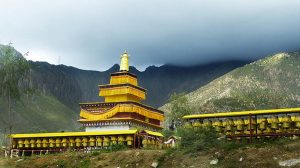
In the morning ,you are going to visit Drepung monastery which is one of the “great three” Gelug monasteries of Tibet, founded in 1416 by Jamyang choge, one of the Tsongkhapa’s main disciples. You can visit biggest monastery kitchen inside the monastery and enjoy Buddhist Sculpture Carving workshop near Drepung.
In the Afternoon, Tourists will visit Sera Monastery which is another one of the “great three” Gelug monasteries of Tibet. The hot attraction is the Monks debate at around 3 – 5 in the afternoon. In addition, you can tour the Tibetan religious scripture printing house; inside the monastery, you can see three sand Mandalas and colorful Rock Painting of Buddha.
Stay overnight in Lhasa.
Day 26 Departure from Lhasa
Sightseeing and Activities:None
Accommodation:
Meals:
The guide will transfer you to the airport or train station and help you get on board.
Quotations
| Group size(person) | 5 Star ($) | 4 Star ($) | 3 Star ($) |
|---|
Service Included:
-
Tibet travel permit and all other necessary permits to Tibet;
-
All entrance ticket fees for all tourist sites listed in the itinerary;
-
Personal knowledgeable English-speaking Tibetan local tour guide;
-
Personal comfortable, clean and safe vehicle with reliable Tibetan local driver; vehicle ranging from 4WD land cruiser to minibus depending on your group size;
-
All lodging listed in the itinerary; it’s your decision about the accommodation class: luxury 5-star international hotel, comfortable 4-star hotel, economic 3-star hotel or budget hostel, guesthouse or tent. Please tell us your accommodation preference when submitting the enquiry; we will arrange the best-value hotels for you.
-
Domestic flight/train tickets listed in the itinerary;
-
All meals listed in the above itinerary;
-
Tourist accident/casualty insurance;
-
First aid kit;
Service Excluded:
-
International flight to and out of China;
-
Chinese visa (Note: we could help you with the Chinese visa application, like providing the invitation letter, presenting the hotel or domestic flight reservation copies, etc that you may need. )
-
Domestic flight/train not listed in the itinerary. (We can provide you the domestic flight/train ticket booking service at the BEST discount price; please contact us our travel experts for the details.)
-
Meals not specified in the itinerary; usually it costs about USD3-15 per person for one meal in TAR (Tibet Autonomous Region).
-
Tips and gratitude to tour guide and driver;
-
Personal expenses, like laundry, phone call, snacks, soft drinks (please do the best to avoid the alcoholic beverages during your Tibet trip), optional tour activities, etc.
Travel Tips:
1. What Are the Features of Our Group Tours
Our Group Tours are budget tour packages with great service which have covered the most popular destinations in Tibet and Yunnan with reasonable trip lengths. Joining in our group tours, you will choose your travel dates from our fixed departures and travel in a small group with maximum members of 12 people.
2. Tibet Permits
There are several permits required to visit Tibet. Tibet Entry Permit, issued by Tibet Tourism Bureau, is the most important one which has to be obtained before your trip because you must have it to take your flight/train to Tibet. To get the permit, you have to book a Tibet tour with us, and send us your passport and Chinese visa about 20 days in advance, and then let us apply for the permit (all Tibet permits can only be applied by travel agency). If you travel to other prefectures like Shigatse, Nyingchi, Shannan, etc, you also have to obtain an Alien Travel Permit. If you travel to Mount Everest, you have to obtain a Border Permit. (Tibet Discovery, with office in Lhasa, has always kept up with the latest news on Tibet Permits. Traveling with us, all your permits are guaranteed as long as you are qualified to the requirements.)
3. Available Months to Visit Tibet
Generally speaking, you can travel to Lhasa all year around. But months from April to October are more recommended. If you want to extend your trip to other regions, such as Shigatse, Mount Everest, Namtso, Ngari, etc, you are suggested to visit during April to October. Other months are usually very cold, and possible have heavy snow, especially in regions like Mount Everest, Mount Kailash, Namtso Lake, etc.
4. High Altitude Sickness
The average altitude of Tibet is about 4000 meters above the sea level (Lhasa: 3700m; EBC: 5200m; Namtso: 4718m). You may suffer a bit from High Altitude Sickness in the beginning days of your Tibet trip if you haven’t had rich high plateau travel experience. But don’t worry too much, the high altitude can be acclimatized usually in 2~3 days. Our suggestion is to take a physical examination and get suggestions from your doctor, and also bring some medicines to prevent from High Altitude Sickness before your trip. While in Tibet, you should keep warm all the time, avoid strenuous activities, drink more water and eat more vegetables and carbohydrates. You’d better not take showers during the first two days after your arrival at Tibet. If you don’t feel well, get help from your tour guide or go to the hospital without any delay.
5. How to Go to Tibet
Basically you have two options – flight and train. Currently, you can take a flight to Lhasa from Beijing(4.5hrs), Xian(3.7hrs), Chengdu(2.5hrs), Chongqing(3hrs), Kuming(3hrs), etc. Among all these cities, Chengdu and Xian have more frequent flights to Lhasa. You can also fly to Lhasa from Kathmandu(1.5hrs) .Xian(32hrs), Chengdu(43hrs), Shanghai(47hrs), Chongqing(42hrs), Lanzhou(25hrs), Xining(22hrs), Guangzhou(54hrs).
6. Packing and Wearing Ideas
Firstly you can’t forget your passport and Chinese Visa. A large backpack and a smaller one are recommended (the smaller one can be used for daily activities). Also bring the necessary medicine you need. Other stuffs like sunglasses, snow glasses, hats, lip balm, sun block are recommended.
As for wearing, you are suggested to dress in layers (both thin and thick jackets). Down jacket is necessary in Spring and Autumn. A pair of durable and comfortable shoes is necessary.

















